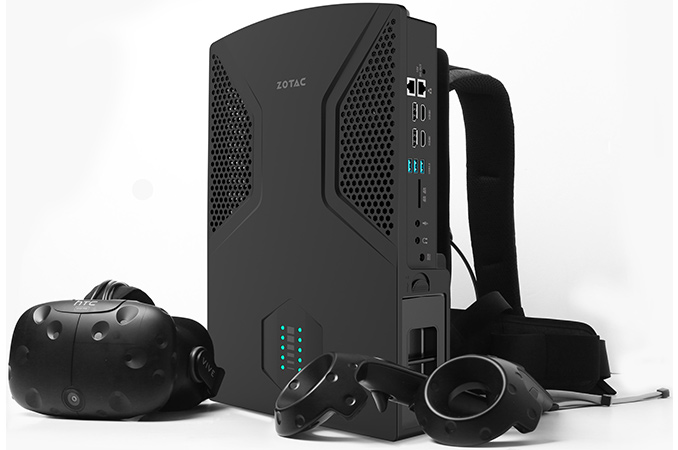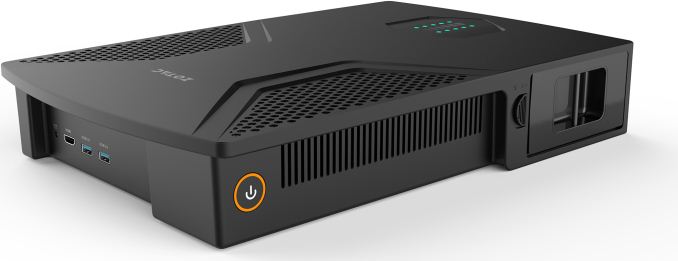ZOTAC VR GO Backpack PC Gets Priced: Core i7-6700T, GeForce GTX 1070, $1999
by Anton Shilov on November 30, 2016 2:00 PM EST
ZOTAC this week plans to start sales of its VR GO backpack PC designed for virtual reality enthusiasts. The system uses a quad-core processor from Intel, and is equipped with NVIDIA’s GeForce GTX 1070 graphics processor and comes with I/O capabilities, just like any normal desktop. The manufacturer plans to sell only fully configured VR GO backpacks for $1999, but the PCs can be upgraded by end-users themselves in a bid to meet their requirements.
ZOTAC formally introduced its VR GO backpack PC earlier this month, but kept the final specifications under wraps. This week, the company revealed that the system will feature Intel’s Core i7-6700T CPU, NVIDIA’s GeForce GTX 1070 GPU with 8 GB of GDDR5 memory (MXM module), 16 GB of DDR4-2133 RAM as well as a 240 GB M.2 SSD with PCIe 3.0 x4 interface from an undisclosed supplier. End-users can then upgrade the VR GO machines with a 2.5” SATA SSD (obviously, nobody wants a hard drive in a backpack PC due to extreme failure risks) as well as install up to 32 GB of DRAM. In theory, the CPU and the GPU could be swapped for higher-performance parts, but since the proprietary low-profile air cooling system was designed with the particular components (the i7-6700T and the GTX 1070) and TDP (150W) in mind, such upgrade would be considerably trickier.
Meanwhile, I/O capabilities of the ZOTAC VR GO are clearly worth a mention as the system has an HDMI 2.0 output as well as two USB Type-A ports on top to connect a VR headset as well as four additional USB 3.0/3.1 Type-A ports, four display outputs (two HDMI 2.0, two DP 1.3), an 802.11ac Wi-Fi + BT 4.2 module, two GbE ports, an SD card reader as well as two 3.5-mm audio jacks.
| ZOTAC VR GO Specifications | |
| ZBOX-VR7N70-W2B/W4B-BE/J/U/K | |
| CPU | Intel Core i7-6700T 4 cores/8 threads |
| PCH | unknown 100-series |
| Graphics | NVIDIA GeForce GTX 1070 2048 stream processors 128 texture units 64 ROPs 256-bit memory interface 8 GB of GDDR5 8 GT/s memory |
| Memory | Two SO-DIMM slots 16 GB DDR4-2133 installed compatible with up to 32 GB of DDR4-2133 |
| Storage | 240 GB M.2/PCIe SSD + one extra 2.5"/SATA bay |
| Wi-Fi | 802.11ac + BT 4.2 |
| Ethernet | 2 × GbE ports (Realtek) |
| Display Outputs | 3 × HDMI 2.0 2 × DP 1.3 |
| Audio | 3.5 mm audio in and 3.5 mm audio out |
| USB | 6 × USB 3.0 Type-A (5 Gbps) |
| Other I/O | DC12V-out for HTC Vive |
| Dimensions | 410 mm × 270 mm × 76 mm 16.14 × 10.63 × 2.99 inches |
| Weight | update: 4.95 kilograms |
| PSU | External |
| Batteries | 2 batteries, rated at 95Wh, 6600mAh |
| OS | Windows 10 Home |
| Price | $1999.99 |
The ZOTAC VR GO can work autonomously for two hours (obviously, the figure depends on applications used) on two Li-ion batteries rated at 95Wh (6600mAh). The batteries can be hot-swapped and charged separately. When not in use as a backpack to play virtual reality games, the VR GO can be used like a normal desktop computer: its form-factor allows it to be placed on a desk either vertically or horizontally and all the ports will remain accessible.
ZOTAC will sell its VR GO backpack PC with Windows 10 Home for $1999 in the U.S. The MSRP of the system is similar to the price of MSI’s VR One backpack computer that became available earlier this month. Each system has its own set of peculiarities, which is good as we see a competition in an emerging segment. For example, ZOTAC’s VR GO for $1999 has the GeForce GTX 1070 GPU, whereas a comparable MSI’s VR One 6RD comes with the GeForce GTX 1060. On the other hand, MSI’s machine has a Thunderbolt 3 port and comes with Windows 10 Pro, whereas ZOTAC’s backpack has a desktop-friendly form-factor and more I/O ports, but uses Windows 10 Home. To sum up, VR enthusiasts now have at least two models of backpack PCs to choose from. Meanwhile, both are quite expensive for niche PCs.
Source: ZOTAC

















14 Comments
View All Comments
shabby - Wednesday, November 30, 2016 - link
At that price they should probably include 6-8 batteries so you can charge/swap/charge/swap continuously.nathanddrews - Wednesday, November 30, 2016 - link
All I can think of:http://1.bp.blogspot.com/_MQquAuiuf4k/S9nFvbW7qaI/...
HomeworldFound - Wednesday, November 30, 2016 - link
I bet they'll only sell about 15 of these.beginner99 - Thursday, December 1, 2016 - link
Can anyone explain me the point of this? Do the VR headsets only ship with short cables?PseudoKnight - Thursday, December 1, 2016 - link
The idea is two-fold, I think. First, cables get in the way (and wireless latency is too high). When you're constantly having to avoid tripping on them, you're distracted from the game. Of course, you're trading that for a not insignificant weight on your back. Secondly, theoretically there are experimental game/production ideas that could involve larger room spaces that would make cabling even more problematic or impossible. It could fill an interesting niche.On a side note, it could be nice for LANs too, as infrequent as they've become.
Is it going to be the mainstream concept for VR? Of course not. Price drives that more than anything. But this concept is the best it gets with no cables for at least a year or two. I'd like to see just a laptop harness that works for this as a better alternative, but of course it'd only work for certain laptops.
PseudoKnight - Thursday, December 1, 2016 - link
Example of experimental games using larger room spaces: https://www.zerolatencyvr.com/It supports multiple players. If you have a large enough space, you can trick people into thinking they're going straight when they're really going in a circle. You can make infinitely roaming spaces.
milkod2001 - Thursday, December 1, 2016 - link
Looks like VR will go to history as the most $$$ wasted tech companies tried to re-invented again and again.BrokenCrayons - Thursday, December 1, 2016 - link
It's a solution looking for a problem that doesn't exist. I just can't see it emerging from its current niche with the technology currently have at our disposal or will have in the near term. It probably should be revisited in a decade or two, but right now it's still priced out of reach for high consumer demand that will offer software developers enough incentive to write appealing programs to take advantage of the equipment.fanofanand - Thursday, December 1, 2016 - link
I'm not as certain as you are. Having only briefly experienced VR (and crappy Gear VR at that) I can tell you this is a new experience for most people. Far different than 3D, VR actually provides a unique experience that cannot be had anywhere else. True, today's VR is nothing like what will be available in a decade, but I do think the tech is there if one has enough money. When the headsets become wireless (the ad/ax spec should help this tremendously) and house 5-8k screens it will be absolutely lifelike. Of course today that kind of setup would likely cost thousands, but as technology evolves prices will come down and market adoption can start. I do not see this being a gimmick like 3D.Guspaz - Thursday, December 1, 2016 - link
That's barely more than 10% battery by weight, and would probably only last half an hour. It's not clear to me why they don't use mobile parts with a larger battery.